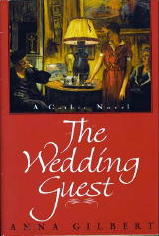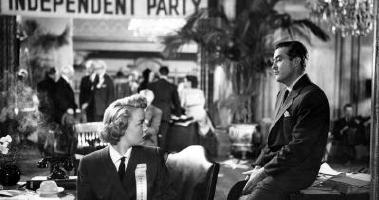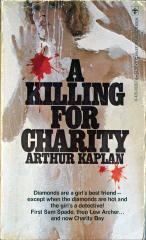June 2008
Monthly Archive
Sat 21 Jun 2008
ANNA GILBERT – A Morning in Eden.
St. Martin’s; hardcover; First US Edition, Dec 2001. UK edition: Robert Hale, 2001. No paperback editions.

A couple of quick reactions first. (a) No diehard private eye fan will ever read this slow-moving tale of adolescent romance in a remote village in England, just after the close of World War I. (b) Time and place are both important aspects of the story, and yet very little of the outside world intrudes — soldiers are coming home from the war, trying to fit into society again — but it’s all very incidental, hardly a major theme.
After the death of one aunt, young Lorna Kent goes to live with another. In isolated Canterlow, she realizes that her infatuation with the local headmaster must be kept secret.
She also discovers she is surrounded by swirls of other mysteries around her. Even more sinister secrets abound — most centering around the death (suicide or murder?) of another young girl not too long before.
Ominous writing prevails, filled with constant portent, imbued with the sadness of nostalgia and the regrets of life that could have been. Decisions made that could not be undone.
More than the mystery to be solved, the reader begins rather to wonder when Lorna will make her own right decision — glaringly obvious, if she were only to see.
— December 2001
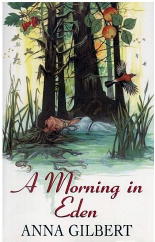
[UPDATE] 06-21-08. Anna Gilbert was the pen name of Marguerite Lazarus (1916- ), making her 85 years old when this book appeared. (I have used “was” in the past tense only because I am fairly sure she is no longer writing; I have found no information to say that she has passed away.)
[Unfortunately I was wrong when I wrote this last statement. Marguerite Lazarus died in 2004. See the first comment below for a link to a well-written and heartfelt tribute to her.]
Here, using the Revised Crime Fiction IV, by Allen J. Hubin, as the primary source, is a complete list of her crime-related fiction (the dash (-) indicating only minor relevance to our field.)
These are the British editions; most if not all have been published in the US, all but one by St. Martin’s. (This list does not include a few novels with no criminous component.)
# Images of Rose (n.) Hodder 1974 [England; 1883]
# The Look of Innocence (n.) Hodder 1975 [England; 1800s]
# A Family Likeness (n.) Hodder 1977 [England; 1800s]
# -Remembering Louise (n.) Hodder 1978
# The Leavetaking (n.) Hodder 1979 [England; 1880s]
# Flowers for Lilian (n.) Hodder 1980 [England; 1800s]
# Miss Bede Is Staying (n.) Piatkus 1982 [England; 1800s]
# The Long Shadow (n.) Piatkus 1983 [England; 1800s]
# A Walk in the Wood (n.) Piatkus 1989 [England; WWII]
# The Wedding Guest (n.) Piatkus 1994 [England; 1920 ca.]
# -A Hint of Witchcraft (n.) Hale 2000 [England]
# A Morning in Eden (n.) Hale 2001 [England; post-WWI.]
Quoting very briefly from Contemporary Authors:
Marguerite Lazarus writes Victorian stories of mystery, deception, and intrigue. Her ability to create realistic Victorian settings and characters is the result of her interest in the literature, memoirs, letters, and biographies of the time. In
Twentieth-Century Romance and Historical Writers, Elizabeth Gray wrote that Lazarus’ “work is stylish and elegant. She writes with fastidious care, making every word count… and she is past mistress at the art of heightening tension by placing a gentle finger on the reader’s nerves.”
Sat 21 Jun 2008
MAX BRAND – The Outlaw Redeemer.
Leisure; paperback reprint, March 2004. Hardcover edition: Five Star, 2000.
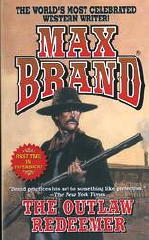
In one way or another, most traditional westerns have elements of crime fiction inherently built into their plot structure, and naturally I wouldn’t have brought it up if both of the short novels in the case at hand, The Outlaw Redeemer, did not abundantly qualify, but in different ways.
In “The Last Irving,” which takes place in the more recent Old West – there is electricity in Irvington, and the characters drive proudly around in flivvers – the heir to the non-existent Irving fortune, a city yokel by the name of Archibald, returns from the East to revenge himself on the two crooks who conned his Uncle Ned out of his life’s savings. This a standard tall tale of a (perceived) dumb sap who (it is anticipated) comes out on top by the simple expedient of setting his two opponents one against the other.
While there is more anticipation than there is follow-through, I can’t imagine anyone not finding the ending at least mildly satisfying.
The title story, “The Outlaw Redeemer,” comes with some unexpected surprises, however, making it by far the more enjoyable one of the two.
The opening is nothing more than Biblical in nature, with lots of “begat”s that trace the lineage of the tale’s two antagonists, the pure in heart John Tipton, who becomes a Texas Ranger whose constant quarry is the brutish and devilish criminally-minded Hubert Dunleven, nicknamed either Shorty or Bunch, “both of which were derived from his physical peculiarities.”
Their efforts directed against each other are the stuff that legends are made of – can a western ever be called utterly charming? Dunleven is that rarest of beings, an outlaw with a silver tongue. Take for example, this speech he makes to the beautiful Nell – oh, yes, there is a girl, and of course she comes between them. But first, from page 118, after he has requested that she make breakfast for him, a request she cannot refuse:
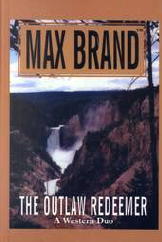
“For instance,” he [Dunleven] explained, “there are your hands. Hands have an eloquence all their own. Your small brown ones, for example, have never before served a meal to a hungry man without enjoying their work. They have been gay and swift and tireless. They have carried dishes to every hungry table with a certain charming eagerness. And it has been a sad thing to sit here and to watch those hands working like slaves, heavily, joylessly, dragging themselves along.”
Nell is not, however, emphasis not, your usual western heroine. As the two male protagonists of the tale, she also is flawed, and I confess – I admit it – I did not know, with several chapters remaining to go, which way the story was going to come out.
That is it a happy ending, you may rest assured. You may be assured that you will not know in which way it will end happily, but it will.
PostScript: Both of the these stories first appeared in the pulp magazine, Western Story. “The Last Irving” appeared as “Not the Fastest Horse,” as by John Frederick in the November 7, 1925, issue; and “The Outlaw Redeemer” appeared as “The Man He Couldn’t Get,” as by George Owen Baxter in the February 27, 1926, issue.
In some substantial way, I like the original titles better.
Thu 19 Jun 2008
DONALD HAMILTON – The Ambushers
Gold Medal k1333, paperback original. First printing: 1963. Reprinted several times.
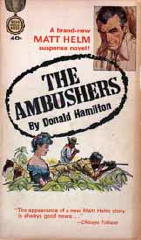
When readers and critics talk about hard-boiled writers, Donald Hamilton’s name never seems to come up, and it should. There may be two reasons for this. First, he didn’t write about private eyes. His primary hero, who appeared in 27 spy fiction novels for Gold Medal between 1960 and 1993, was Matt Helm, a hard-as-nails agent for an unnamed branch of the US government, but still not a private detective. Secondly, Dean Martin, and those godawful movies. I enjoyed them at the time, but I was only in my 20s. What can I tell you?
In the order of appearance, this is the 6th in the series. Starting in a Latin American country falsely called Costa Verde, where Helm takes out the leader of a gang of cutthroat revolutionaries, back to Washington, then out west to Tucson and into northern Mexico, where a leftover Nazi overling has been spotted, Hamilton doesn’t let the story die of the doldrums, to say the least.
There is a girl. Reminiscent of many John D. MacDonald stories, this one needs a rescue, and then some therapeutic rehabilitation. But in this case, Sheila, the agent who ran into problems in Costa Verde, is an essential part of the story, and its ending as well.
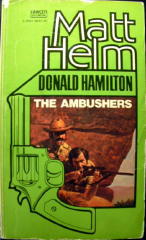
As for Helm, he improvises quickly, making (for example) being caught in a trap all part of the plan, and he has no false compunctions or misgivings about what his job entails. He’s in a rough line of work, no doubt about it, with little or no tolerance for error. James Bond is more famous than he, with more of a Continental flair (and better movies) but by a good margin, Matt Helm is the tougher of the two.
— July 2002
[UPDATE] 06-19-08. My comment at the beginning of this review may have been true when I wrote it, but in the six years between then and now, I think Donald Hamilton has been given his due, at least on blogs and the Internet, if not in terms of new editions of his books at Borders and Barnes & Noble. (Hard Case Crime has reprinted Night Walker, a non- Matt Helm book, and I hope it has done well.)
So it may be that neither Helm nor Hamilton are truly forgotten, but the Matt Helm books have been so long out of print that anyone in their 20s now is very likely never to have heard of him in the first place. Unless they read blogs like this one, and Bruce Grossman’s reviews over at bookgasm and Bill Crider on his blog and John Fraser on his website …
[UPDATE #2] Just after posting this, I went to check my email and by some uncanny coincidence, I discovered that Ed Crocker had posted a long reminiscence about Donald Hamilton on an earlier post here on the Mystery*File blog, back when Hamilton’s death was first reported. I’ve kept what he had to say there, but I’ve moved it here as well. It’s the first comment you’ll see below. Thanks, Ed!
Wed 18 Jun 2008
CHARLAINE HARRIS – Shakespeare’s Champion.
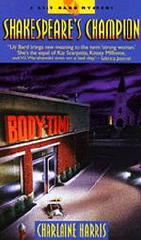
Dell; paperback reprint, November 1998. Hardcover first edition: St. Martin’s, December 1997. Later paperback edition: Berkley, December 2006.
You could have fooled me, and I was. I didn’t see it coming. I thought this book was one of those “cozy” mysteries that have been flooding the paperbacks shelves at Borders and other outlets over the past ten years or more. What with ice-skating detectives, teddy-bear-collecting detectives, quilting detective, herbal-shop-owner detectives, fudge-making detectives — which is not to put any of them down, as long-time readers of this blog know that most certainly do I not make a habit of — I was caught leaning the wrong way this time, and Ouch.
Lily Bard is the detective in this one, her second appearance of five so far, and she cleans houses for a living in a small town named Shakespeare, somewhere in Arkansas. What would you think, if that were all you knew about the series?
My guess is that you’d be wrong, too. There are more dead bodies in this than any Robert B. Parker books you’ve read, and if you stacked two or three of them together, the count might then just start to be close.

There are some things I was unhappy about in this book, the criminous part focusing on racial hatred and violence, but neither that fact nor Lily Bard herself is one of them. She’s quite a lady, having come to Shakespeare to run away from her past, but she works out nearly every morning in the local gym (body building and karate), and does not take any sass from anybody. Hard-boiled, flinty — but in a totally feminine sense — independent. Name it, she’s it.
I may as well start enumerating some of the problems I had with the book, even though I still haven’t told you much about the story line. First, the prologue, which is not told by Lily, while the rest of the book is. I hate prologues, especially when they are as useless as this one.
Secondly, while I can understand Lily’s reticence in talking about her past — and she doesn’t for the longest time in this one — she already has in the first one. Revealed her secrets, that is, to at least some of the people in her new life.
This means that someone who’s already read the first book, as I haven’t, would be reading a totally different book than I was, as he or she would already know the players and the tensions (many sexual) between them, and I didn’t. Lily’s conversation with Claude Friedrich, the local chief of police, as she spurns his amorous advances — soon after the discovery of the first body (although it really isn’t– the first body, that is) — makes a lot more sense later on, then it does in Chapter One. The reader of book one knows, but the reader of book two hasn’t a clue.
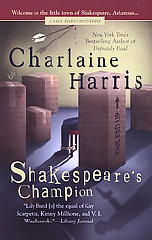
I’m making this complicated, but going back and re-reading what I just wrote, it’s correct, and I think I will stay with it the way it is. There has been a series of deaths in Shakespeare, and only gradually are they revealed, and of course they’re important. The blurb on the back cover puts things in the right order, chronologically, but I have to admit that this is only a minor quibble, although a frustrating one, as the characters’ actions reflect what they know, and we (the reader) do not.
But here’s the greatest problem I found with this book. With a scene of violence as horrific as the one that occurs in this book — if it were to have happened in the real world — it would have made national headlines, news crews from every channel on the cable dial would have been in town, snooping around 24/7, and a real investigation would have gone on, the ending not relying on three people sneaking around at night to uncover the culprits and their plot on their own. And in spite of all of the bloodshed, this strictly amateurish way of nabbing the killers is perhaps what makes this dark and sobering tale story a “cozy” mystery after all.
Would I read another Lily Bard tale, though? You bet I would. She’s quite a lady.
POSTSCRIPT. I know they’re too small for the details to be all that helpful, but each of the cover images that I’ve found to add to this post illustrate three different but still vitally important aspects of the book, and in three different styles. I like all three of them.
Wed 18 Jun 2008
LESLIE CHARTERIS – The Saint in Trouble.
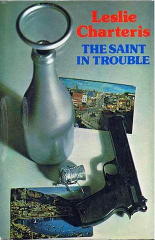
Detective Book Club; hardcover reprint (3-in-1 edition), May 1979. Coronet, UK, paperback, 1978. First UK hardcover edition: Hodder & Stoughton, 1979. Doubleday Crime Club, US, hardcover, 1978. No US paperback edition.
Although this reprint volume doesn’t mention it, Charteris apparently had very little to do with this book. According to Al Hubin’s Crime Fiction IV, the book was adapted by Graham Weaver from original teleplays by Terence Feely and John Kruse.
Which certainly explains a lot. Charteris may have had something to do with final revisions, but there’s not much substance to either of the two short novels in this book. I was reminded more of the James Bond movies (not the books) than anything else, without all of the spectacular visuals. (And without that, what’s left?)
In “The Imprudent Professor”, the Saint (Simon Templar, aka Sebastian Tombs) helps prevent a scientist from defecting to the Soviet Union. It seems he has a solar energy alternative to fossil fuel, and the Free World cartels insist on keeping the discovery covered up.
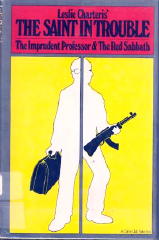
The sunny Cannes background is nice, and Simon meets at least two very good-looking young ladies, but (as far as I can tell) one of the pieces of evidence the Saint proceeds on never occurred.
To verify that certain things never change, in “The Red Sabbath” Simon returns to London to help a (good-looking) female Israeli agent track down a Arab terrorist trying to defect from his comrades to South America. Again we get a intimate inside look at the London underworld, but beyond that, it’s a matter only of luck and fortunate timing that helps the dashing modern-day privateer prevail.
Except for the lapse of a kind mentioned above, the writing is polished enough, but the stories themselves are rather superficial and perfunctory. A disappointment.
— January 2002.

[UPDATE] 06-19-08. Now that I have resources (the Internet) that I did not have when I wrote this review — or I was too new at it then to use them — I can now tell you that I’ve identified “The Imprudent Professor” has having been televised on 19 November 1978 as part of the series The Return of the Saint, starring Ian Ogilvy. (“The Red Sabbath” remains unidentified.)
The series played in the US as The Friday Late Night Movie on CBS, or so I understand, but I don’t remember seeing it, or even knowing about it — and in spite of my generally negative reaction to the book, I’d have liked to have.
Maybe copies still exist? I’ll check into it.
Tue 17 Jun 2008
A REVIEW BY MARY REED:
EDGAR WALLACE – The Daffodil Mystery. Ward Lock & Co., UK, hardcover, 1920. U.S. title: The Daffodil Murder. Small Maynard & Co., 1921. Many reprints, both hardcover and paperback. Film: Omnia-Rialto, 1962, as The Devil’s Daffodil (Das Geheimnis der Gleben Narzissen) (scw: Basil Dawson, Donald Taylor; dir: Akos Rathony).
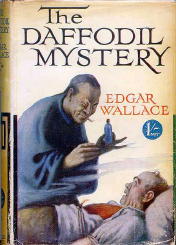
Odette Rider loses her cashier job after she indignantly rejects a suggestion from Thornton Lyne, owner of the large store where she works, that they cohabit without benefit of clergy.
As a result Lyne, a thoroughly mean-spirited man, plots to frame her for embezzlement of company funds even though he knows the real culprit is a departmental manager, Mr Milburgh.
Lyne’s cousin Jack Tarling, late of the Shanghai Detective Service, has just opened an investigative agency in London’s Bond Street and visits Lyne to discuss the Milburgh matter. When Tarling learns Lyne wants to pin Milburgh’s defalcations on Miss Rider – Milburgh of course being more than happy to go along with the idea – he refuses to have anything to do with it.
As part of his general posing as a charitable fellow, Lyne has become acquainted with Sam Stay, burglar and jail bird, who is due to be released from prison next day. As usual, Lyne meets him, gives him breakfast and twenty pounds, and tells such outrageous lies about Miss Rider that he succeeds in getting Stay interested in helping his benefactor “get even” with her.
The day after Tarling warns Miss Rider of the possibility of Lyne taking revenge Lyne is found murdered, his body laid out in Hyde Park with a pad formed from one of Miss Rider’s nightgowns and some of her hankies used in an attempt to staunch his gunshot wound – and a bunch of daffodils laid upon his chest.
He is wearing slippers, and a small piece of red paper with Chinese characters on it is in his waistcoat pocket, although that garment, his coat, and his boots are in his car a hundred yards away from his body. Tarling interprets the writing as saying Lyne brought trouble upon himself.
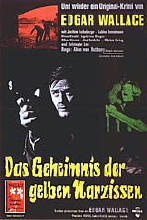
Tarling goes to visit Miss Rider at her mother’s house in Hertford. Things look bad for her, not only because of the nighty and hankies but also because a shot was heard in her flat the night before. But Miss Rider has disappeared. A warrant is issued for her arrest and Tarling, who has fallen for her, embarks on a quest to find her, establish her innocence, and discover who was responsible for the murder of the odious Lyne – and the motive behind the crime.
My verdict: Readers’ notions of likely suspects are cleverly led along until a plot twist turns them on their heads, while the machinations of Mr Milburgh will make some almost admire his cleverness – until they learn the nasty depths of his nature. The murderer is the person most readers will least suspect. And will any of them be able to look a daffodil in the trumpet again without recalling their mental picture of the corpse in Hyde Park?
Etext: http://www.gutenberg.org/etext/20912
Tue 17 Jun 2008
REVIEWED BY WALTER ALBERT:
H. BEDFORD-JONES – Fang Tung, Magician. Detroit, MI: Beb Books, 2007.
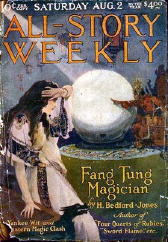
This oriental thriller by a prolific and popular pulp writer was originally published in the All-Story Weekly issue for 2 August 1919. Brian Earl Brown, the entrepreneurial chap behind Beb Books, specializes in cheap reprints (the text, in stapled wraps) that he was selling at the table opposite mine at Pulpcon last year.
This entertaining novelette, about a Chinese messianic magician who wants to chase all foreigners out of the country, in its often careless style betrays the pressure under which pulp writers worked, but the writer’s imagination carried this reader over the rough spots.
Bedford-Jones was no Sax Rohmer, but he’s working somewhat in the same vein, and the combination of a charismatic villain, a pure and feisty heroine, and an adventuresome journalist is a winning one here. And the $5 price was just right for this minor adventure thriller.
Sun 15 Jun 2008
NICHOLAS BLAKE – Thou Shell of Death.
Berkley F1002; paperback reprint, 1964. Hardcover first edition: Collins Crime Club (UK), 1936. US hardcover first edition: Harper & Brothers, 1936, as Shell of Death. [Reprinted in The Nicholas Blake Treasury (Volume 1), Nelson Doubleday, 1964, containing: Thou Shell of Death; The Beast Must Die; and The Corpse in the Snowman.] Other US paperbacks: Penguin, US, 1944, as Shell of Death; Perennial, US, 1977, as Thou Shell of Death.
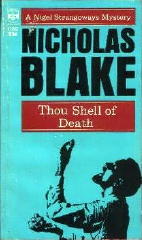
Even though they have the same author — Nicholas Blake — what a night and day difference there is between this book and the previous one by him, reported on here. This is the second mystery Blake wrote — the first was A Question of Proof — and it’s the second appearance of Nigel Strangeways as well.
The conventions of the Golden Age of Detection are very much evident in this earlier book — complete with anonymous threatening letters, a call for assistance from the recipient, an aging but still engaging ex-flying hero of the previous war, a house party at Christmas time with all of the possible suspects in attendance.
And then death strikes. Is it suicide? Only one set of footprints are found in the snow leading to the small hut where Fergus O’Brien’s body is found.
Or is it murder? Strangeways’ deductions soon answer the question in positive fashion, solving as he does the “locked room” aspect of the case in quick order. By that I mean by page 72, out of a total of 192. (Paperbacks were thin and the print was small, back in 1964.)
But I digress. More mysterious doings occur, all of them complicating the mystery even more, rather than clearing them up at all. It is all rather fascinating and interesting and static until (a) Nigel takes a quick trip to Ireland to uncover some facts about the past, and (b) he returns to Dower House only to find himself falling in love with one of the possible suspects, regretting greatly that his prior hypotheses made her one of the primary ones, in the eyes of Scotland Yard.
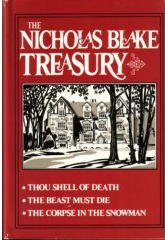
As a detective, Nigel himself seems to be only an amateur, in the finest sense of the word. He is called upon in this instance due to the fact that his uncle, Sir John Strangeways, is an Assistant-Commissioner of Police. This allows the dilettantish Nigel to conduct his investigations with the full cooperation of the authorities, if not their down-right awe and admiration.
I’m not sure that dilettante is precisely the right word. From the Internet comes the following definition: a dabbler: an amateur who engages in an activity without serious intentions and who pretends to have knowledge. Nigel Strangeways is serious all right, and he puts the pieces of the puzzle in excellent fashion.
If the early Ellery Queen took after Philo Vance, then I believe that Nigel Strangeways follows in the same footsteps as that very same Ellery Queen, whether directly or in parallel — I have no way of knowing whether Cecil Day-Lewis ever read any of the Queenian adventures or not, but they’re cut from the same cloth, no doubt about it.
As for the case in hand, inspired by a 17th century work by a playwright not previously known to me, Cyril Tourneur, who published The Revenger’s Tragedy in 1607. [NOTE: See Al Guthrie’s comment.] The title of Blake’s work, Thou Shell of Death, comes from a direct quote, which I dare not repeat, for fear of, um, forsooth, revealing too much.
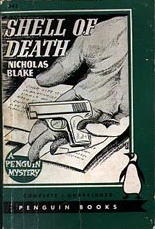
It takes Nigel the entire last chapter, eighteen pages (small print), to untangle all of the twisted threads of the plot, remarking once on a remarkable (well, yes) coincidence that made the killer’s plan succeed the way that it did, not mentioning the much huger one that initiated the entire sequence of events in the first place.
That, plus the entire sheer unlikelihood of anyone plotting such a strikingly complex, ingenious, and therefore inept scheme in the second place — well, that’s simply the joy of author trying to outwit reader that makes the reading — and the challenge — all the more pleasurable.
Blake’s own career, as seen by the earlier post on this blog, eventually went in other directions, as did Ellery Queen’s in tandem. But which kind of story was better, and which are they better known for today? You tell me.
—
Sun 15 Jun 2008
ALIAS NICK BEAL. Paramount, 1949. Ray Milland, Thomas Mitchell, Audrey Totter. Screenwriter: Jonathan Latimer, based on a story by Mindret Lord. Director: John Farrow.
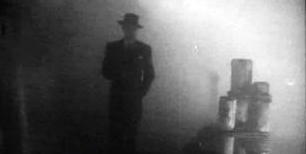
First of all, you may as well go watch this short clip from the movie at YouTube right now, as long as you come back. It’s the first time the viewer gets to see Nick Beal on the screen, played to superb perfection by the ultra-urbane (and more than slightly creepy, in a subtle but obvious, just-under-your-skin sort of way) by Ray Milland, an actor who throughout his career could apparently play both hero and villain with equal ease.
Meeting him at this rundown waterfront bar is Joseph Foster (Thomas Mitchell), an ambitious but reform-minded District Attorney who doesn’t know it yet, but who has eyes on the governor’s office. Mitchell played rumpled and generally honest guys like this by hardly getting out of bed.
I’m going to tell you something now that I didn’t know when I started to watch the movie (or was able to conveniently forget), so if you don’t want to know, stop reading now. For some reason this movie is not readily available on video or DVD, but every write-up about it — and there are quite a few of them — talks about it freely, so I think that maybe I won’t be revealing anything too crucial by continuing.
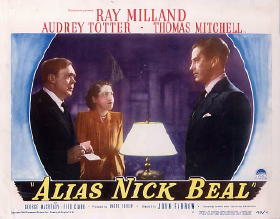
Still with me? As the story goes, or at least this one does, if Nick Beal is not the Devil, he has strong connections to him.
If this first scene doesn’t come out and say so, each time he’s on the screen again, he simply knows too much or can do too much and pretty soon he’s got Foster in the palm of his hand, urging him on as only the Devil could do: “Think of all the good you could do if you were the governor,” he says, the unspoken context and agreement being: no matter how you get there or who you have to consort with to do so.
Is this noir? If you’ve seen the film clip, how could you say no? Is this a crime film? No, not unless a few cheap gangsters, blackmail (on the part of Nick Beal), graft and corruption on a strictly state and city level makes a movie a crime film, and then, of course, it is.
What this is movie really is a fantasy film, not a soft fluffy one, but one with some sharp corners and awfully hard edges. And with the atmosphere of seduction and crime always in the background — did I mention Audrey Totter yet? If I haven’t, I will. And with, as I began to say, seduction and crime the absolute focal point of this morality tale of ambition and greed, the movie is as noirishly dark as anyone could wish for.
Until the ending that is, and if noir means unhappy endings, than this isn’t noir. Unless noir means learning about the darkness that exists in everyone’s heart, and even when he’s bested once or twice, a third time out of three is good enough for the likes of Mr. Beal.
Audrey Totter plays Donna Allen, a woman who has traversed far too many bars in her young lifetime — presumably as well a lady of ill-repute — but here I am going into things the movie dares not quite come out and say. But recruited by Mr. Beal with promises to her of the finer things in life, she goes to work for Mr. Foster, and upon Beal’s request, soon has him in the palm of her hand, ready to leave his wife and do things with her that 48-year-old men have no right thinking about doing with anyone other than their wives.
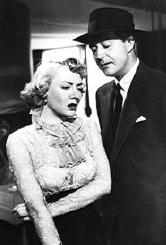
None of which we see, and which probably didn’t happen, but might have, and about we can easily surmise what Thomas Mitchell’s character would have like to have happened if it didn’t.
In this film, though, we see another side of Audrey Totter, the actress. Quite often in the films she’s in — see Tension, in which she plays the two-timing wife of druggist Richard Basehart as a prime example — her characters are always tough and totally in contempt of the men whose emotions she plays with.
In Alias Mr. Beal, we also see that she can play a character of a less hard-boiled nature, and she’s a marvel to watch as she gradually begins to realize, to her dismay, just whom she has fallen in league with.
A lot of the attraction for many films that are hard to find copies of is that, well simply, that they’re hard to find. Their reputation is enhanced, in other words, by their unavailability. That’s somewhat the case here. I’d heard many good things about this movie, without knowing most of the details, that when I finally got to see the film, its immediate impact was less than I’d anticipated.
No matter. A score card rating of 80% isn’t at all bad, at least in my book, especially since it’s an 80% based on already enhanced expectations.
[UPDATE] 06-17-08. Not being very happy that I hadn’t provided a better photo of Thomas Mitchell, I went looking for one, and here’s what I came up with. Rather nice, in my opinion:
Sun 15 Jun 2008
IT’S ABOUT CRIME
by Marvin Lachman
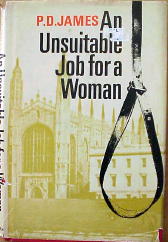
The Private Eye novel, I’m thankful, is still with us though recent events show that type of detective might eventually become our latest folk heroine. First, we had the female op who stole the show from Inspector Dalgleish in P.D. James’ An Unsuitable Job for a Woman (1972), relegating him to a bit part. I still believe Mrs. James is missing a good bet for another series character.
Charity Bay, Arthur Kaplan’s detective in A Killing for Charity (1976) started as secretary to a San Francisco detective and, after learning the job, moved to New York where she charges an inflationary $300 a day, plus expenses, for her services. Kaplan has his titular detective display her very good figure to advantage. Charity begins the book by having intercourse with a man to set him up for an arrest. Later, Kaplan gets her into one of those clothes-torn, figure-exposed situations that pulp illustrators thrived on.
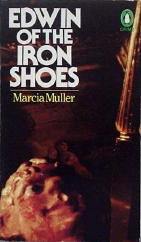
In Marcia B. Muller’s Edwin of the Iron Shoes (1977), female private detective Sharon McCone remains in San Francisco where she does investigative work for a store-front legal cooperative. McCone develops a relationship with art-loving Lt. Greg Marcus, S.F.P.D. Except for the possibility of romance, they get along together as the Marlowes et al have traditionally gotten along with the official police.
The book, except for one good scene authentically describing the Seal Rock area, ends in a blaze of … coincidence. Kaplan and Muller have proven that the only limitations on the success of female private detectives in the future will be the artistic limits of their creators.
Books reviewed or discussed in this installment:
P. D. JAMES – An Unsuitable Job for a Woman. Faber, UK, hardcover, 1972. Scribner, US, hc, 1973. Many paperback reprints in both countries. Film: Boyd, 1981 (scw: Elizabeth MacKay, Brian Scobie, Christopher Petit; dir: Petit). Four episode TV-series (ITV-PBS), 1997-1999, one installment of which was based on this book. NOTE: Besides the TV series, Cordelia Gray made one additional appearance in book form, a solo case recorded in The Skull Beneath the Skin (Faber, UK, 1982).
ARTHUR KAPLAN – A Killing for Charity. Coward-McCann, hardcover, 1976; Berkley, pb, 1977. NOTE: This was the only appearance of Charity Bay.
MARCIA MULLER – Edwin of the Iron Shoes. David McKay, hardcover, 1977. Penguin, US, pb, 1978. Several other US paperback editions. Women’s Press, UK, pb, 1993. NOTE: This was Sharon McCone’s debut entry. She has since appeared in 25 novels and nearly as many short stories.
Reprinted from the
The MYSTERY FANcier, Mar-Apr 1979.
« Previous Page — Next Page »


